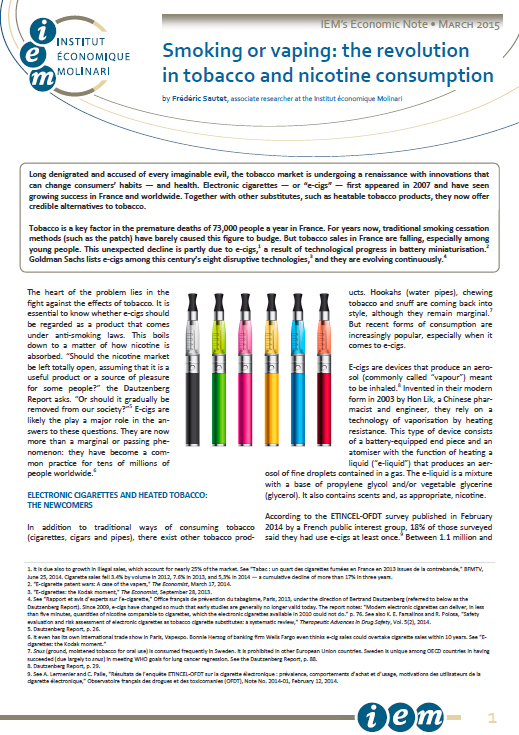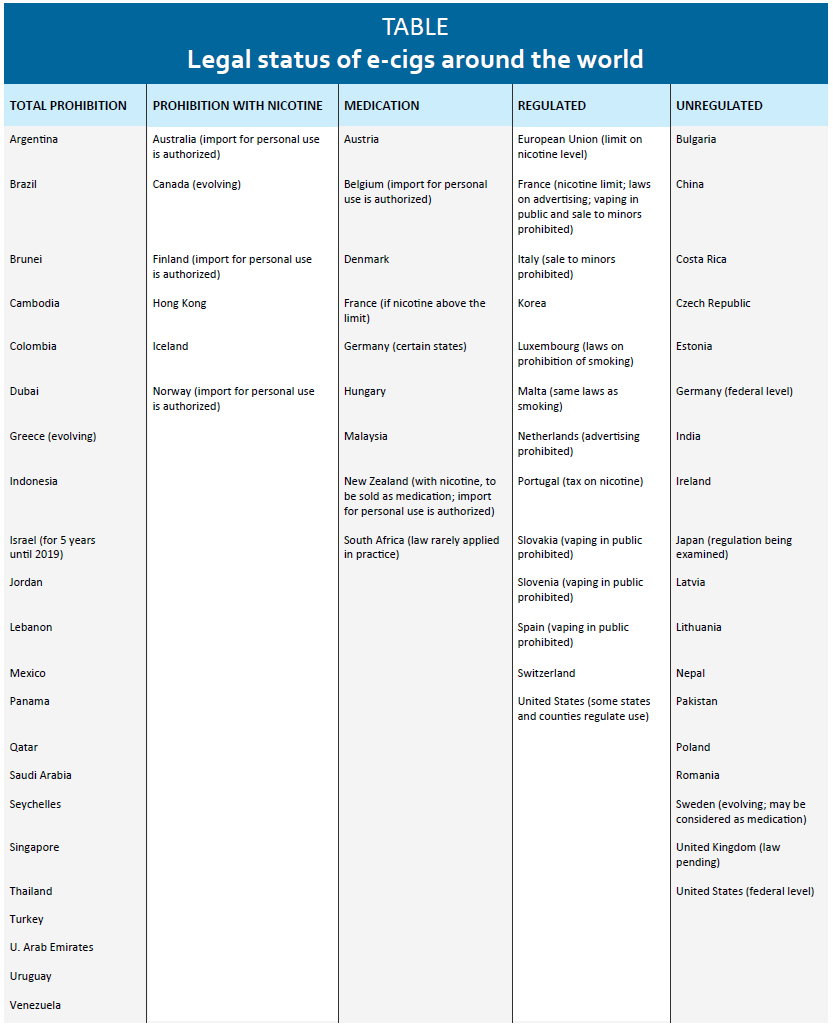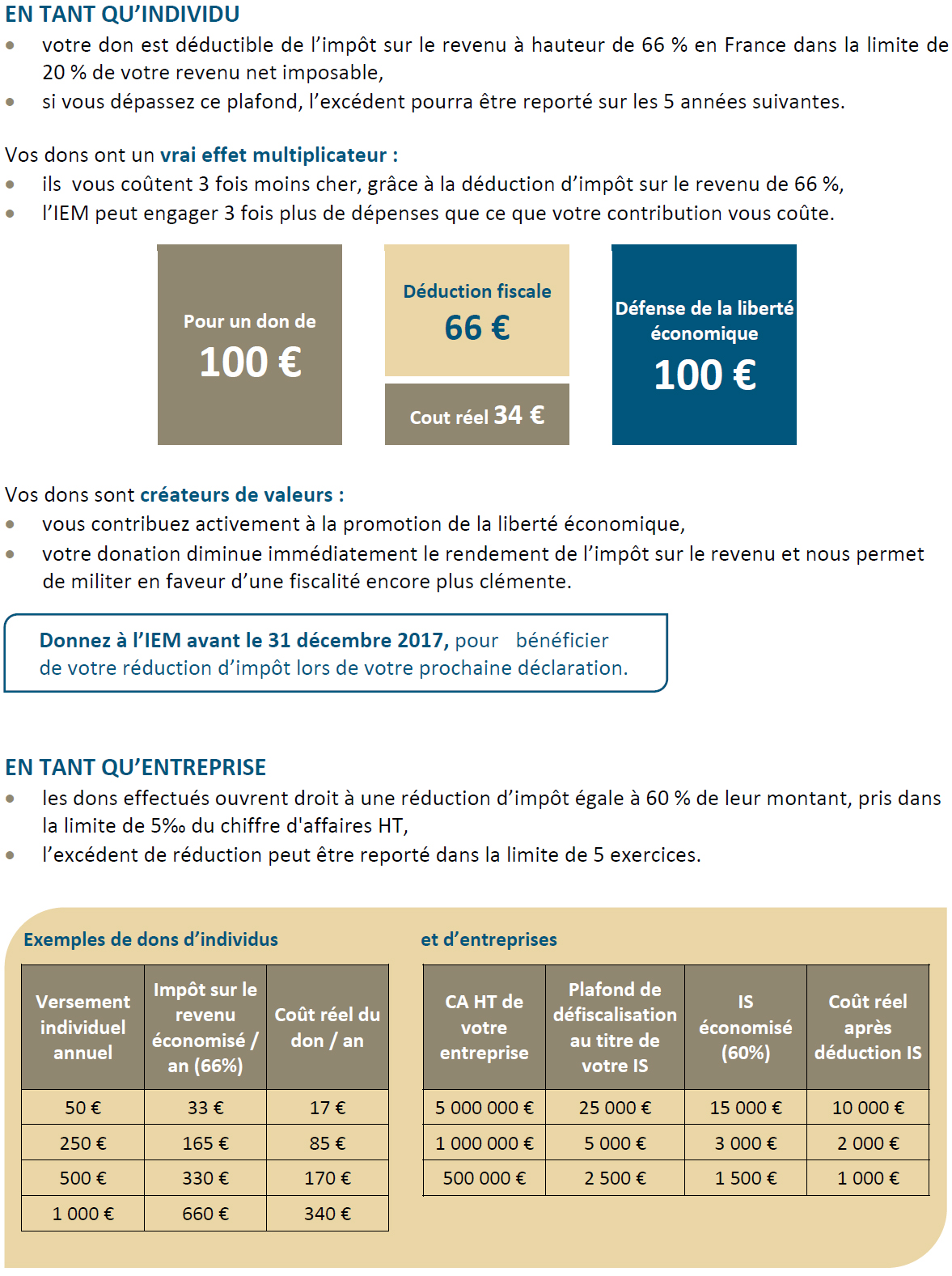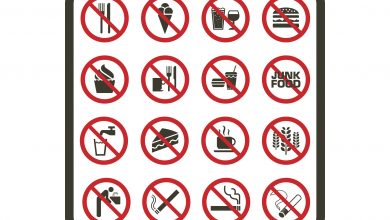Smoking or vaping: the revolution in tobacco and nicotine consumption
Economic Note

Economic Note prepared by Frédéric Sautet, associate researcher at the Institut économique Molinari.
Media release: Smoking or vaping: the revolution in tobacco and nicotine consumption
Long denigrated and accused of every imaginable evil, the tobacco market is undergoing a renaissance with innovations that can change consumers’ habits — and health. Electronic cigarettes — or “e-cigs” — first appeared in 2007 and have seen growing success in France and worldwide. Together with other substitutes, such as heatable tobacco products, they now offer credible alternatives to tobacco.
Tobacco is a key factor in the premature deaths of 73,000 people a year in France. For years now, traditional smoking cessation methods (such as the patch) have barely caused this figure to budge. But tobacco sales in France are falling, especially among young people. This unexpected decline is partly due to e-cigs,(1) a result of technological progress in battery miniaturisation.(2) Goldman Sachs lists e-cigs among this century’s eight disruptive technologies,(3) and they are evolving continuously.(4)
The heart of the problem lies in the fight against the effects of tobacco. It is essential to know whether e-cigs should be regarded as a product that comes under anti-smoking laws. This boils down to a matter of how nicotine is absorbed. “Should the nicotine market be left totally open, assuming that it is a useful product or a source of pleasure for some people?” the Dautzenberg Report asks. “Or should it gradually be removed from our society?”(5) E-cigs are likely the play a major role in the answers to these questions. They are now more than a marginal or passing phenomenon: they have become a common practice for tens of millions of people worldwide.(6)
ELECTRONIC CIGARETTES AND HEATED TOBACCO: THE NEWCOMERS
In addition to traditional ways of consuming tobacco (cigarettes, cigars and pipes), there exist other tobacco products. Hookahs (water pipes), chewing tobacco and snuff are coming back into style, although they remain marginal.(7) But recent forms of consumption are increasingly popular, especially when it comes to e-cigs.
E-cigs are devices that produce an aerosol (commonly called “vapour”) meant to be inhaled.(8) Invented in their modern form in 2003 by Hon Lik, a Chinese pharmacist and engineer, they rely on a technology of vaporisation by heating resistance. This type of device consists of a battery-equipped end piece and an atomiser with the function of heating a liquid (“e-liquid”) that produces an aerosol of fine droplets contained in a gas. The e-liquid is a mixture with a base of propylene glycol and/or vegetable glycerine (glycerol). It also contains scents and, as appropriate, nicotine.
According to the ETINCEL-OFDT survey published in February 2014 by a French public interest group, 18% of those surveyed said they had use e-cigs at least once.(9) Between 1.1 million and 1.9 million people (numbers that are rising continually), or nearly 3% of the population, are everyday users. In the United States, sales went from $500 million in 2012 to $2 billion in 2014. This is small compared to the $80-billion cigarette market, but it is growing quickly. Total trading volume worldwide was evaluated at $3 billion in 2013.(10)
Even the tobacco multinationals are getting involved. They undoubtedly wish to avoid the fate of Kodak, which disappeared after failing to go digital. Some of them are investing in the development of new products or in the purchase of start-ups.(11) Innovation is brisk. In December 2014, there even emerged an e-cig made of cannabis extract, with no psychotic effect. This shows the disruptive capabilities of e-cigs in relation to the tobacco market.
Tobacco products are also changing, going back to 1988, when low-smoke Premier cigarettes came onto the market. In 1994, there was Eclipse, and in the late 1990s Accord. Heatbar, the most recent of them, uses a tobacco vaporisation process. None of these attempts has succeeded in creating a market.(12)
Ploom, launched in France in 2014 by Japan Tobacco International, involves tobacco capsules that are heated without burning, using a vaporisation system that relies on the Nespresso principle. Since there is no combustion, Ploom is a “clean cigarette” or “reduced-risk cigarette.” Doctors are wary, because there is not yet any conclusive study on this subject.(13) That is not preventing competitors from moving forward. The new smoke-free Iqos cigarette from Philip Morris is an example of this.
ELECTRONIC CIGARETTES: ARE THEY EFFECTIVE AT REDUCING SMOKING?
One third of everyday vapers are former smokers, and two-thirds are current smokers.(14) What is at issue in terms of public health is whether e-cigs can create dependency among non-smokers and whether they can maintain dependency among tobacco smokers who have gone over to e-cigs.(15)
The initial conclusions are promising, despite some disagreements among scientists. Nicotine is a poisonous and addictive product regardless of how it is administered. E-cigs may quite possibly be addictive for non-smokers.(16) However, e-cigs appear to be a better way to quit smoking than nicotine replacements. Evidently, “the risk of prolonged nicotine intake is far lower [with e-cigs] than continuing to smoke.”(17) E-cigs provide nicotine without certain by-products of tobacco combustion (tars and carbon monoxide).
As regards the poor results from traditional cessation methods (e.g., patches, gum, compresses), an alternative such as e-cigs is welcome, even if it is not perfect. It is a matter of relative and not absolute effectiveness. E-cigs work better than traditional smoking cessation products, sales of which have been falling since 2010.(18) Not even nicotine inhalers provide the same satisfaction as e-cigs. It takes 25 minutes for inhalers to produce relief from lack of nicotine. E-cigs take much less time and also have the advantage of lesser side effects than inhalers.(19) It is also a matter of the ability to reproduce the vaper’s sensation on the throat when inhaling.(20)
A growing number of scientific articles show e-cigs to have a significant effect in tobacco cessation. An article published in Addiction magazine under the direction of Dr Jamie Brown shows positive effects from e-cigs in quitting smoking. E-cigs are 60% more effective in helping smokers cease than free will alone or other methods already on the market.(21) Results from two studies conducted by Peter Hajek and his team, published in 2014, show that e-cigs with nicotine increase the chances of tobacco cessation over the long term compared to e-cigs without nicotine.(22) A study from KU Leuven University found that nearly one-quarter of smokers lowered their cigarette consumption by half after trying e-cigs for eight months.(23)
In a 2014 survey, the association “Paris sans tabac” (Tobacco-free Paris) found a significant decline in the number of young people who smoke. They accounted for 11.2% of secondary school pupils (down from 20% in 2011) and 33.5% of students at the lycée level (compared to 42.9%). Young people are turning to e-cigs: 90% of young smokers have already tried them. Bertrand Dautzenberg thinks young people’s attitudes toward tobacco are changing, and this favours e-cigs. Moreover, it appears they are not a gateway to cigarettes. Dautzenberg, as well as other specialists such as Gérard Mathern,(24) say e-cigs are contributing to the decline of tobacco. Although this interest in e-cigs among young people may not be to everyone’s liking, it may be contributing to a significant reduction in smoking.(25)
Regulations (including higher taxes) against smoking since France’s Evin law of 1991 have had a certain impact, especially among males. But the potential impact of e-cigs seems to be far greater. This is partly because vapers seek to avoid the carcinogenic elements of cigarettes. The ETINCEL-OFDT survey shows that the primary motivation of vapers is total cessation. Some 43% of French people find e-cigs to be an effective means of cessation. This makes it appear to be an exit door from smoking rather than an entryway.(26) Even Health Minister Marisol Touraine, a fierce opponent of tobacco, admits that using e-cigs to quit smoking is a good idea, though this is not stopping her from seeking to regulate them.(27)
REGULATIONS AND ELECTRONIC CIGARETTES
Regulations on the use of tobacco products rest on two pillars. First is the idea that smoking is bad for the smoker’s health because tobacco combustion releases Category 1 carcinogens.(28) There is also the notion that smoke is bad for the health of people around the smoker, in other words passive smoking.
A. Passive smoking is not what it was
Passive smoking also exists with vaping (we will be hearing about “passive vaping”) as well as with heated tobacco. Studies examining this phenomenon are rare. Other than being rather pleasant to breathe, it seems that e-cigs have few effects on those nearby. At issue is whether the aerosol released by e-cigs contains hazardous elements.
With tobacco smoke, the pollution comes mostly from particulate matter. With e-cigs, it is mostly gaseous. According to the Dautzenberg Report, the risks from the droplets contained in e-cig aerosol are theoretically more than 100 times lower than the risks from exposure to tobacco smoke.(29) But passive vaping is not entirely free of danger. After exposure to e-cigs, serous cotinine (a metabolite of nicotine) is found at levels almost identical to those from cigarettes.(30) However, e-cig aerosol does not produce passive exposure to either the carbon monoxide or the solid particles found in cigarette smoke. According to the Dautzenberg Report, the quantity of known carcinogens in e-cig aerosol is far lower than that in cigarette smoke.(31)
However, a report from Japan’s National Institute of Public Health, published in November 2014, states that the aerosol contains formaldehyde along with acrolein, glyoxal and methylglyoxal.(32) The level of formaldehyde, a known carcinogen, may be up to 10 times higher than what cigarette smoke contains.(33) But this level is not constant, and it varies according to many factors.
The greatest concern arises from the effects of the nicotine and its derivatives found in the aerosol. Priscilla Callahan-Lyon thinks exposure to the aerosols may lead to respiratory problems, but this remains to be verified.(34) Despite this, it would appear that e-cigs largely, though not completely, diminish the problems related to passive smoking. Thus, it is far from clear that a ban on vaping in public places is needed if the effects on others are minor.(35) Some people say this ban would reduce the attractiveness of e-cigs for smokers. Even so, the Dautzenberg Report recommends a ban for exemplary purposes, clearly a form of paternalism.(36)
B. Electronic cigarettes, a product apart?
In France, e-cigs are considered a common consumer product. They are neither a tobacco product nor a medication unless they claim a beneficial effect on health and contain more than 10 mg of nicotine with a concentration above 20mg/ml.(37) But according to the Dautzenberg Report, e-cigs are not a common consumer product. The report seeks the establishment of a new category of tobacco-free products containing nicotine providing for appropriate regulations to be implemented.(38) The question arises as to what specific regulations are needed.
E-cigs are banned in various countries around the world. Other countries consider it a medication, requiring special authorisation to put it on the market, with sales restricted to pharmacies (see the Table). A total ban now seems impossible in France, given how much the market has developed since 2010.(39) The European Union (UE) decided on October 8, 2013, not to classify e-cigs as medication.(40) New legislation adopted by the EU on February 12, 2014, does not ban e-cigs, but most of the measures end up restricting rather than encouraging its use. This legislation authorises a nicotine level of 20 mg/ml in 2-ml atomisers.(41) French specialists have mostly welcomed this decision favourably. Classifying e-cigs as medication would have had a negative effect on market development.

Countries where e-cigs are banned face growing illegal imports.(42) It remains to be seen whether total bans can be maintained in the future. Some jurisdictions are choosing regulations rather than total bans. New York City has banned vaping in public places.(43) E-cigs are also banned in restaurants in Chicago.(44) Three U.S. states have banned vaping where traditional cigarettes are also banned. Eighteen other states have imposed fairly tough regulations on e-cig use. In addition, 274 cities or counties have laws that restrict vaping.(45) The U.S. Food and Drug Administration (FDA) announced in 2014 that it intended to extend its powers to regulate e-cigs.
The most serious arguments in favour of regulating e-cigs are based on the hazardous nature of the e-liquid. Propylene glycol (which provides for a good rendering of scents) is usually considered safe. However, it is an excipient that is not completely neutral. It may cause irritations, allergic reactions and, in rare cases, a condition close to drunkenness.(46) There is little information on its toxicity when inhaled repeatedly in the form of a hot aerosol. The same is true of glycerol, which provides for a more abundant aerosol. This product presents a theoretical risk of acrolein formation when the temperature rises and the molecule dehydrates.(47) The e-liquids also contain impurities such as anatabine, norcotinine and anabasine.(48)
These are substances close to nicotine found by dint of the fact that nicotine is never 100% pure. On the other hand, e-cigs are nearly devoid of nitrosamines, which are carcinogens naturally present in tobacco.(49) But they do contain acetone, acetic acid, chlorinated solvents and formaldehyde (which may result from heating propylene glycol). It seems that the heated scents are what lead to the most serious question. Upon contact with hot resistance, scents are likely to be altered.(50) These scents often contain acetine, diacetin, ambroxide and parabens.(51)
Apart from the Japanese study, the research up to now shows no major carcinogenic potential in the e-cig aerosol, because concentrations are low. The World Health Organization (WHO), however, recommends against vaping until its safety has been proven scientifically. The WHO also focuses on scents used in the e-liquid that may help attract young people to e-cigs and make them regular consumers, something that remains to be proven.(52)
CONCLUSION: INNOVATION IN THE SERVICE OF PUBLIC HEALTH
E-cigs are an example of a product that develops without major regulatory constraints at this stage. And this market is working well. Supply meets demand, meaning consumers’ wishes.(53) E-cigs and heated tobacco products are innovations that are disrupting consumption among tens of millions of users. In 2014, there were more than 460 e-cig brands worldwide.(54) The market is still young.
One way of managing the problems of a developing market is to let it select the best producers while imposing basic standards on e-liquid content.(55) Already, some producers are no longer using ambroxide, diacetin or parabens.(56) Brands with reputations are being built, and this will continue to advance product quality. It has been possible to observe a very positive shift in product quality since 2009, particularly with a growing number of producers using pharmaceutical-quality constituents.(57) In the U.S., the American E-Liquid Manufacturing Standards Association was created in 2012. This is a market response for setting production standards. Associations of this type can play a beneficial role even though they can also become instruments for lobbying. If manufacturers and distributors are not protected by regulations, the market will continue to produce greater quality.
It is still too early to judge the full effects of e-cigs. That will take one or two decades of use by hundreds of thousands of users. Although new technologies may often raise questions, that is not a reason to prohibit them. In the late 1990s, there was a question as to whether cell phones posed a serious health risk. A risk existed, but benefits from use were enormous. We know now that the risks from e-cigs are by no means non-existent but they are potentially quite low in relation to traditional cigarettes.
About the author
Frédéric Sautet holds a doctorate in economics from the Université de Paris Dauphine and did his post-doc at New York University. He has been an economic advisor at the New Zealand Treasury and a senior economist at the Commerce Commission (New Zealand competition watchdog). He taught economics at the Université de Paris Dauphine, New York University, George Mason University and at The Catholic University of America. He started collaborating with IEM in 2014.
References
1. It is due also to growth in illegal sales, which account for nearly 25% of the market. See “Tabac : un quart des cigarettes fumées en France en 2013 issues de la contrebande,” BFMTV, June 25, 2014. Cigarette sales fell 3.4% by volume in 2012, 7.6% in 2013, and 5,3% in 2014 — a cumulative decline of more than 17% in three years.
2. “E-cigarette patent wars: A case of the vapers,” The Economist, March 17, 2014.
3. “E-cigarettes: the Kodak moment,” The Economist, September 28, 2013.
4. See “Rapport et avis d’experts sur l’e-cigarette,” Office français de prévention du tabagisme, Paris, 2013, under the direction of Bertrand Dautzenberg (referred to below as the Dautzenberg Report). Since 2009, e-cigs have changed so much that early studies are generally no longer valid today. The report notes: “Modern electronic cigarettes can deliver, in less than five minutes, quantities of nicotine comparable to cigarettes, which the electronic cigarettes available in 2010 could not do.” p. 76. See also K. E. Farsalinos and R. Polosa, “Safety evaluation and risk assessment of electronic cigarettes as tobacco cigarette substitutes: a systematic review,” Therapeutic Advances in Drug Safety, Vol. 5(2), 2014.
5. Dautzenberg Report, p. 26.
6. It even has its own international trade show in Paris, Vapexpo. Bonnie Herzog of banking firm Wells Fargo even thinks e-cig sales could overtake cigarette sales within 10 years. See “E-cigarettes: the Kodak moment.”
7. Snus (ground, moistened tobacco for oral use) is consumed frequently in Sweden. It is prohibited in other European Union countries. Sweden is unique among OECD countries in having succeeded (due largely to snus) in meeting WHO goals for lung cancer regression. See the Dautzenberg Report, p. 88.
8. Dautzenberg Report, p. 29.
9. See A. Lermenier and C. Palle, “Résultats de l’enquête ETINCEL-OFDT sur la cigarette électronique : prévalence, comportements d’achat et d’usage, motivations des utilisateurs de la cigarette électronique,” Observatoire français des drogues et des toxicomanies (OFDT), Note No. 2014-01, February 12, 2014.
10. In 2017, it could top $10 billion. See “Consolidation en vue chez les géants du tabac,” Les Echos, May 23, 2014.
11. In 2012, Lorillard, an American tobacco company, purchased Blue eCigs. R. J. Reynolds Tobacco Company, the maker of Camel cigarettes, acquired the Niconovum e-cig brand. See the Dautzenberg Report, p. 172, and “Consolidation en vue chez les géants du tabac.” Some commentators expect the market to grow tighter, with three-quarters of e-cig companies acquired by tobacco multinationals by 2017. See “E-cigarette : l’industrie du tabac contre-attaque,” Le Monde, April 15, 2014.
12. Dautzenberg Report, p. 104. See also “L’e-cigarette provoque des débats autour de sa réglementation,” Le Temps, September 22, 2013.
13. But Geneva-based anti-tobacco activist Jean-Francois Etner is asking to see, because it is possible that these new products may reduce the toxicity of tobacco. See “La piste d’une cigarette proper,” Le Temps, February 14, 2014.
14. See “Synthèse thématique : tabac et cigarette électronique”, Observatoire français des drogues et des toxicomanies, November 2014.
15. Dautzenberg Report, p. 85.
16. Dautzenberg Report, p. 88.
17. Dautzenberg Report, p. 90.
18. See “Synthèse thématique : tabac et cigarette électronique.”
19. Dautzenberg Report, pp. 50-51.
20. See “L’e-cigarette provoque des débats autour de sa réglementation.”
21. J. Brown, E. Beard, D. Kotz, S. Michie, R. West, “Real-world effectiveness of e-cigarettes when used to aid smoking cessation: a cross-sectional population study,” Addiction, 109, 2014, pp. 1531-1540.
22. H. McRobbie, C. Bullen, J. Hartmann-Boyce, P. Hajek, “Electronic cigarettes for smoking cessation and reduction (Review),” The Cochrane Library, Issue 12, 2014. Another New Zealand study from 2013 study shows that cessation levels are higher with e-cigs than with traditional cessation methods. C. Bullen, C. Howe, M. Laugesen, H. McRobbie, V. Parag, J. Williman, N. Walker, “Electronic cigarette for smoking cessation : a randomised controlled trial,” The Lancet, September 2013.
23. “La cigarette électronique calmerait l’envie de fumer,” Sciences et Avenir, November 21, 2014. Dr Jean-Paul Humair, director of the Geneva-based Centre d’information et de prévention du tabagisme, suggests vaping to reduce tobacco use, because he regards evidence of e-cigs’ effectiveness as adequate. E-cigs have positive effects in reducing tobacco-caused symptoms such as coughing, sputum, etc. See “Nous avons commencé à proposer de vapoter pour réduire l’usage du tabac,” Le Temps, 2013-11-22.
24. General secretary of the Société française de tabacologie.
25. See “The Wisdom of Children,” vaping.com, June 25, 2014. For a study tending to show that e-cig encourage cigarette use among adolescents, see L. M. Dutra and S. A. Glantz, “E-cigarettes and conventional cigarette use among US adolescents: A cross-sectional study,” JAMA Pediatrics, National Institute of Health, 168(7), 610-7, 2014.
26. “Résultats de l’enquete ETINCEL-OFDT sur la cigarette électronique,” p. 8. See also the Dautzenberg Report, p. 123.
27. “Mieux vaut vapoter que fumer” (“Better to vape than to smoke”), she said. See “Paquets neutres, vapotage : Marisol Touraine dévoile un plan anti-tabac ambitieux,” Les Echos, September 25, 2014.
28. Dautzenberg Report, p. 62.
29. Dautzenberg Report, p. 95. “Not even in the most extreme conditions are levels seen as toxic reached in a room where e-cigs are used.” Dautzenberg Report, p. 96.
30. Dautzenberg Report, p. 98.
31. Dautzenberg Report, p. 78.
32. “La cigarette électronique est, elle aussi, cancérigène,” Les Echos, November 27, 2014.
33. It should be noted that the Dautzenberg Report (p. 97) found concentrations of formaldehyde five to 10 times higher in tobacco smoke than in e-cig aerosol.
34. P. Callahan-Lyon, “Electronic cigarettes: human health effects,” Tob Control, 23, ii36-ii40, 2014. See also R. Grana, N. Benowitz, and S. A. Glantz, “E-Cigarettes: a scientific review,” Circulation, 129, 1972-86, 2014. The authors also doubt the aerosol’s safety.
35. Except for confined public places such as aircraft. But this may be determined by airline companies’ internal regulations. On this point, read the discussion between Bertrand Dautzenberg and Brice Lepoutre, “Faut-il craindre l’e-cigarette?,” Le Figaro Magazine, June 14, 2013.
36. Dautzenberg Report, pp. 101 and 177. Rather than the precautionary principle, the report suggests the exemplarity principle. See also “Faut-il craindre l’e-cigarette ?”. In this regard, Marisol Touraine’s anti-tobacco plan is intended to prohibited vaping in workplaces, on public transport and in public places. The ban could be extended to restaurants. Advertising will be restricted and then banned in May 2016, in accordance with the European tobacco directive. See “Marisol Touraine présente le Programme national de réduction du tabagisme,” Ministère des Affaires sociales, de la santé et des Droits de la femme, September 25, 2014.
37. Dautzenberg Report, p. 155.
38. Dautzenberg Report, p. 193.
39. It should be noted that Switzerland initially prohibited e-cigs with nicotine, but the Federal Council later retracted this. See “Les e-cigarettes avec nicotine seront tolérées, mais pas encourages,” Le Temps, May 22, 2014. Swiss vapers often cross the border to buy e-liquid containing nicotine. See “L’irruption de l’e-cigarette bouleverse la consommation de nicotine,” Le Temps, February 14, 2014.
40. See Text P7_TA(2013)0398 and Amendment 165, Proposal for a directive, Recital 33, which states: “Given the potential of nicotine-containing substances to aid smoking cessation, Member States should ensure that they can be made available as widely as tobacco products.” See also the European directive 2014/40/UE, April 3, 2014, and “La directive sur le tabac restreint l’e-cigarette,” Le Temps, February 14, 2014.
41. It should be known that, even with a concentration of 18 to 20 mg/ml, vapers feel a hit on the throat resembling the effect of traditional cigarettes.
42. “E-cigarettes sales will suffer if regulated like tobacco, says analyst,” CTV Kitchener News, 2014-08-30.
43. In force since December 18, 2013. The vote brought e-cigs into the Smoke-Free Air Act. The sale of e-cigs to people under age 21 is prohibited. See “New York interdit le vapotage dans les lieux publics,” Le Temps, December 20, 2013. Christine Quinn, then the City Council Speaker, said e-cigs could again make it normal to smoke in public places, a fear shared by French Health Minister Marisol Touraine.
44. “E-cigarettes: where there is smoke,” The Economist, March 3, 2014.
45. See “U.S. states and local laws regulating use of electronic cigarettes,” American Nonsmokers’ Rights Foundation, January 1st, 2015.
46. But this has been demonstrated only experimentally and in large doses. See the Dautzenberg Report, pp. 40 and 82.
47. Dautzenberg Report, pp. 42 and 62.
48. Dautzenberg Report, p. 51.
49. Dautzenberg Report, p. 52.
50. Dautzenberg Report, p. 37.
51. Containers may also be the source of metals and other particles in the aerosol. This can be solved quite easily through improved manufacturing methods. See “E-cigarette : moins nocive pour l’entourage mais…,” Sciences et Avenir, August 29, 2014.
52. Many specialists, such as Ann McNeill, were surprises by the WHO’s conclusions, which seem too drastic. Jacques Le Houezec joined this chorus of criticism against the WHO because he thinks e-cigs can have a positive effect on public health. See “E-cigarette : des experts dénoncent le rapport trompeur de l’OMS,” Sciences et Avenir, September 8, 2014. E-cig sales to minor have been banned in France since March 17, 2014. For a warning against the risks related to nicotine addiction amongst new vapers, see “ L’avis relatif aux bénéfices-risques de la cigarette électronique étendus en population générale,” Haut conseil de la santé publique, April 23, 2014.
53. In January 2010, there was just a single specialized shop, in Caen. In the course of 2014, there were more than 300 shops and 2,500 points of sale. The available statistics are not entirely clear. Sources: Xerfi and JDN.
54. S.-H. Zhu, J. Y. Sun, E. Bonnevie, S. E. Cummins, A. Gamst, L. Yin and M. Lee, “Four hundred and sixty brands of e-cigarettes and counting: implications for product regulation,” Tob Control, 23, iii3-iii9, 2014.
55. Article 20 of European directive 2014/40/UE sets out safety and quality requirements for e-cigs. This directive will apply under national law as of May 2016. See also the Dautzenberg Report, p. 66.
56. Dautzenberg Report, p. 38.
57. Dautzenberg Report, pp. 45-46.







